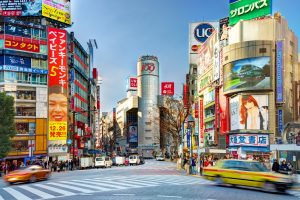Tokyo is awash with “redevelopment” (saikaihatsu) projects. The abundance of recently completed, ongoing, and proposed projects also brings substantial attention and praise to Tokyo for fostering an attractively cosmopolitan, future-oriented city. Yet these projects share a revealing characteristic: collectively they advance a city riven with expanding segregationist intent, eager to bring forth more intrusive levels of control, exclusion, and surveillance.
Sleek new office towers and an abundance of attractive retail spaces define a growing number of Tokyo neighborhoods. Arguably this trend is most visible in Shibuya, where a now decades-long collection of construction endeavors has comprehensively transformed the area. The scale of change in Shibuya has also made it a template for “redevelopment,” as the various projects are held up as indicative of the future direction Tokyo and Japan aspire to. That appears to be a future where consumerist desires find endless outlets for satiation and work is of a technical nature, oriented toward ill-defined notions of entrepreneurial innovation and sustainable growth. All in a nation where persistent, anxious discussion of the aging and shrinking population, alongside the enduring consequences of an “employment ice age,” has dominated popular and political discourse for more than a generation.
How do these material and physical changes to the urban landscape bring about more consequential transformations to the horizons of lived possibilities and the principles (or lack thereof) that anchor a society? Focusing on the tangible changes in Shibuya, or other sites of notable “redevelopment” efforts, takes one to a place of commentary around the spectacle of the new skyscrapers, architectural attractiveness of emergent retails spaces, or the creative hybridity of mixed use areas eager to highlight the dubious infusion of “green” or “sustainable” dimensions into commercial settings. Focusing instead on what is erased or neglected in these new spaces forces consideration of an entirely different slate of concerns, centered on the manner in which these changes are made possible and who among Tokyo’s varied population is considered or (willfully?) ignored.
The motivations driving Tokyo’s redevelopment enthusiasm also betray its segregationist intentions. The authorities are eager to drive from view those deemed unacceptable in future-oriented depictions of the city and society to come. The unifying characteristic to these projects is greater private control through eviction, displacement, and erasure of any who impede or challenge the monied, consumerist renderings of the future. Recent examples are plentiful: unhoused communities driven from Miyashita and then Mitake parks in Shibuya, followed by similar expulsions at Minami-Ikebukuro Park. Local residents and the unhoused were evicted from homes and parks for the construction of the National Stadium for the 2020 Tokyo Olympics – some of whom were similarly displaced decades earlier for construction projects tied to the 1964 Olympics. The Jingu Gaien redevelopment meant the controversial felling of the iconic Ginko trees. And there are periodic “special cleaning” sweeps at Ueno and other major parks to temporarily evict any unhoused residents so officials can then claim upon inspection that there isn’t an issue with homelessness in such areas.
Organizing all of these examples is a logic of segregation that endeavors to erode public space and enact a society where the ability to gather, or even exist, is predicated on monetary resources. Notions of a public or public space and accompanying institutions that exist for the betterment and enrichment of all are eroded at the behest of private interests and their governing enablers. Terminology as forceful and historically-laden as segregationist is thus necessary, as the destruction of public space fundamentally and violently cripples the most necessary and emancipatory aspects of social life and anything that could be referenced as a civil society aspiring to inclusive democratic values.
In her book “Why Public Space Matters,” anthropologist Setha Low noted emphatically that “public space contributes to the flourishing of individuals, communities, cities, and societies.” Sociologist Eric Klinenberg asserted in “Palaces for the People” that democracy and equality are compromised when the public is made private and monetary exclusion becomes the organizing principle shaping governing decisions. Yet across Tokyo, these conclusions are taken less as warnings and more as aspirational goals.
Such a reality would be frightening but not surprising in more overtly authoritarian settings unencumbered by the presence of purportedly transparent and egalitarian guiding principles. In Tokyo, however, the push to enact a segregationist future comes hidden in a language claiming to want to care for and ensure the uplift of all its citizens. Tokyo’s governor, Koike Yuriko, makes frequent and fond mention of guiding her city toward a future where everyone can “shine” (kagayaku). In the abundance of proposals, policy proclamations, and popular communications the Tokyo Metropolitan and national government put forward, a future Japan where “no one is left behind” (another of the governor’s favored claims) is offered as the prevailing and predictable framing. Coming alongside future renderings of technologically mediated utopias devoid of inequalities, poverty, or neglect, these constitute attractively fraudulent claims, the principle intent of which would seem to be distraction from contemporary practices.
Like the governor, I also desire a Tokyo, Japan, and planet where everyone can shine and no one is left behind. Yet my feeling is that the path to such a future lies in an intellectually honest confronting of the sorrow, precarity, and inequities sown by efforts to destroy public space and expel or expunge anyone who cannot or will not pay to gain entry. As the number who will be left behind compounds, we are collectively left to confront the absurdity organizing Tokyo’s “redevelopment” drive and the future it will assuredly deliver – a future its backers so fastidiously try to hide.

































